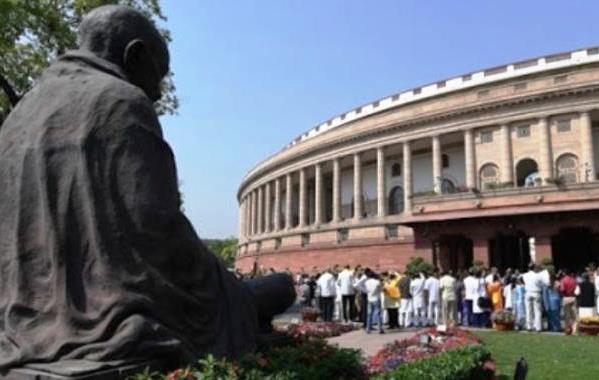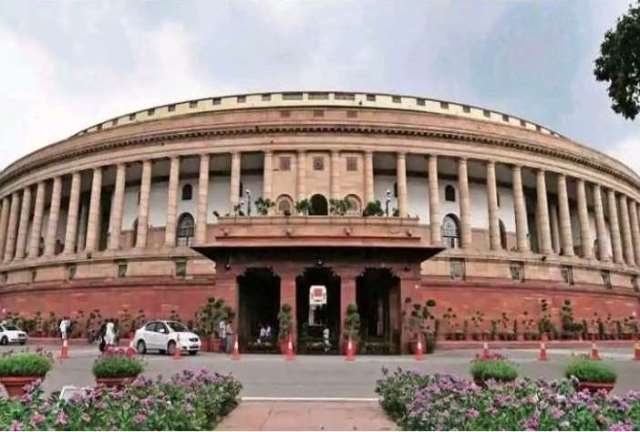A prominent newspaper editor elected to the Lok Sabha routinely joined protests that disrupted proceedings in the House. Asked by a fellow-scribe why he couldn’t be ‘different’, he said, much as he would like to make his mark with his speeches, he knew that his joining slogan-shouting in the Well of the House would get him front-page mention in the newspapers.
He was being candid. To be seen as an ‘active’ parliamentarian, whether or not there is the party’s ‘whip’ on an issue, participation in the ‘pandemonium’ that media routinely reports, pays. Forget the 24X7 politicos, many of those who excel in their respective fields, on being elected to legislature, also follow it.
The days of debating and making erudite speeches are over. Lawmakers with Ox-Bridge education have departed. The oratory in “English by Nath Pai and in Hindi by (Atal Bihari) Vajpayee” is forgotten. Those who dare to speak are now mocked at. No matter which party is in power — crass, high decibel, slogan-shouting is the rule rather than exception.
Now, we have entire sessions being disrupted. Much of Parliament’s time to debate and legislate is wasted in filibustering, name-calling, slogan shouting, loud denunciation, blocking of proceedings and frequent adjournments. Like many legislatures across the democratic world, if that is any consolation, the Indian lawmakers sit – or rather, stand — more often and protest, making it an art, if not industry, with each side, like the kettle, calling the pot black.
India’s Parliament, the circular shape of which will soon disappear into the Central Vista revamp, is like an imperfect merry-go-round. Imperfect, because the going-round, depends on the life of a government and is not uniform. After long years of the Congress rule, an assortment of parties occupied the treasury benches and now a coalition led by the Bharatiya Janata Party (BJP) is at the helm.
Parliament is supposed to meet for 110 days every year and larger state legislative assemblies for 90 days. In effect, amidst acrimony and adjournments, the government of the day pushes through key legislation with little or no debate, even by voice vote. That was how the three farmers’ legislations were passed — the ones that are now being contested. In that sense, the “farmers’ Parliament” being conducted on the streets is a testimony of the failure of the Mother Parliament.
The current Monsoon session, begun on July 19, is about to end August without much debate. The opposition wants to discuss the farm bills, rising prices and the Pegasus spyware snooping scandal, but the government is blocking them. Official figures show that Parliament has only functioned for 18 hours out of the scheduled time of 107 hours, resulting in a loss of more than Rs 133 crore of taxpayers’ money. The Rajya Sabha functioned for only 21 percent of its scheduled time and the Lok Sabha, only 13 percent, for about seven hours out of 54.
These statistics, however, tell only a part of the story. Disruptions have been the only recourse for the opposition of the day, and it has not always succeeded in getting the government to concede. Take the Bofors gun deal controversy, or the Raphael aircraft deal, or any of the scams, from sugar to share market to telecom. Pegasus is only the latest. The fact is that when a contentious issue crops up, the government dithers on debating it, leading to Opposition MPs violating the conduct rules and disrupting the proceedings of Parliament. Since they have the support of their parties in breaking the rules, the threat of suspension from the House does not deter them.
ALSO READ: Modi Govt’s Contempt For Parliament
There is justification, too, for disruptions. Only, when the shoe pinches those in power, blame the cobbler. Congress’ Anand Sharma denies that the opposition is responsible for disruptions and blames the government. A decade earlier, then Leader of Opposition in Rajya Sabha Arun Jaitley had said, “Parliament’s job is to conduct discussions. But many a time, Parliament is used [by the government] to ignore issues and in such situations, obstruction of Parliament is in the favour of democracy. Therefore, parliamentary obstruction is not undemocratic.”
Over the years, with unceasing uniformity the party/alliance in power accuses the opposition parties of stalling proceedings. The latter want a myriad issues discussed, but is not allowed. What has changed now is levelling of a serious allegation, coming repeatedly from the country’s prime minister himself, that the opposition’s blocking the proceedings is “anti-national.” The same was said by another prime minister who compared her critics with Hitler. That was the Emergency era that cannot be justified. Now, the government’s critics allege, it is “undeclared Emergency.”
By a broad-brush comparison and contrast, there is less respect for parliament and parliamentary norms and procedures today and worse, a total lack of mutual trust. The legislature has become an arena of aggression.
The rot began to set in long ago, in the last quarter of the last century, when the likes of Vajpayee, Chandra Shekhar and Indrajit Gupta, the pride of any Parliament, were still around. It is not easy to pin it down to any party or period. All parties are guilty and must share the blame. There seems little prospect of India’s political class doing introspection or reform.
There was acrimony over issues in the past, too. The government and the opposition – within the opposition, from different parties and regions — had differing priorities. They increased as parliament, over the years, became more diverse since the 1980s with more parties representing the electorate. Reflecting complexities of the Indian society and aspirations of a billion-plus people is never easy.
ALSO READ: My Years In Parliament House
Certainly, attempts to set right things were right in the first Lok Sabha. A simple code of conduct was prescribed for Members in 1952. The rules required MPs not to interrupt the speech of others, maintain silence and not obstruct proceedings by hissing or by making commentaries during debates. It seems like utopia today.
Newer forms of protest required updating of those rules in 1989. Accordingly, members were expected not to shout slogans, display placards, tear away documents in protest, play cassettes or tape recorders in the House. Much of it is now on as nobody bothers about rules. The tone of the proceedings has become strident and the language, toxic. More powers were accorded to the presiding officers. Thirteen members were suspended for “unruly behaviour” by the Lok Sabha Speaker last week.
The Supreme Court has sought to affect some change. Its judgment does not directly deal with Parliament but with state legislatures. On Wednesday, the Supreme Court ruled elected representatives could no longer go scot-free for acts of vandalism and violence committed inside a house claiming immunity provided under the Constitution. It takes away the protection of privileges and immunities making elected representatives liable for prosecution for their acts.
You cannot push the clock back. But it is worth noting why the debates during the 1950s and 1960s used to be informative and livelier, when disruption was not used for expressing dissent or opposition. Or, why loss of time was below 10 percent during the 10th Lok Sabha (1991-1996), reached a record high of 40 percent during the 15th Lok Sabha (2009-2014), and threatens to be worse now. Notably, the earlier periods corresponded to the significant increase in penetration of mass media in society (including direct coverage of parliamentary proceedings on TV) and the passage of anti-defection law. These well-meant measures have back-fired, hurting Parliament’s healthy functioning.
A parliamentary democracy is government by discussion. There can be no running away from debates and more time on legislation. Mutual blame-game and disruptions have got to end. The onus is on the executive. Each government has avoided biting the bullet. But who will bell the cat?
The writer can be contacted at mahendraved07@gmail.xom


